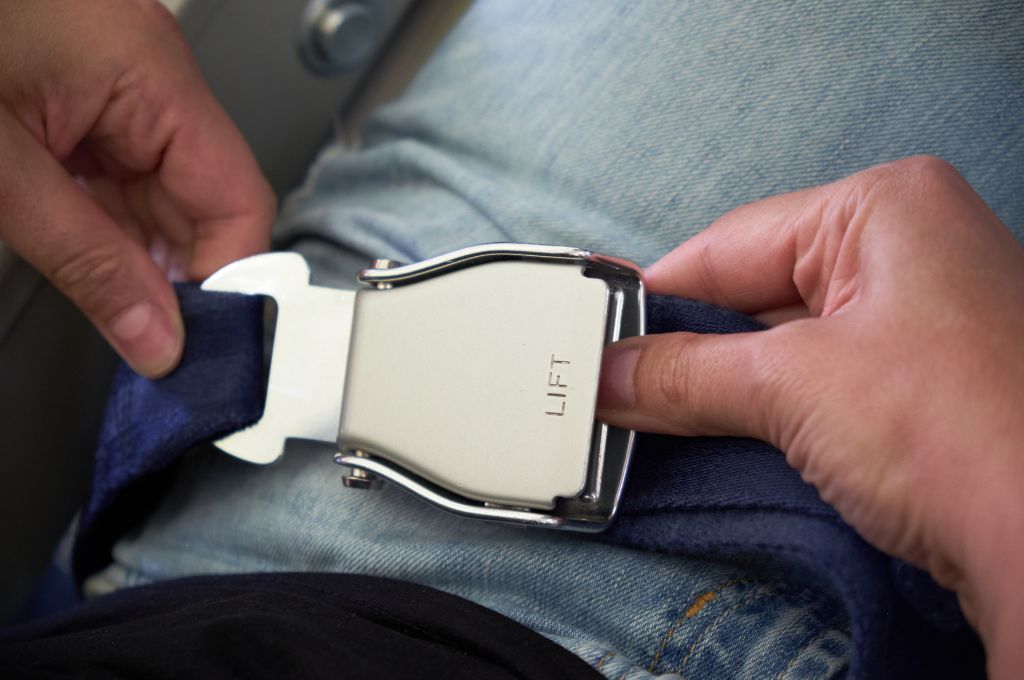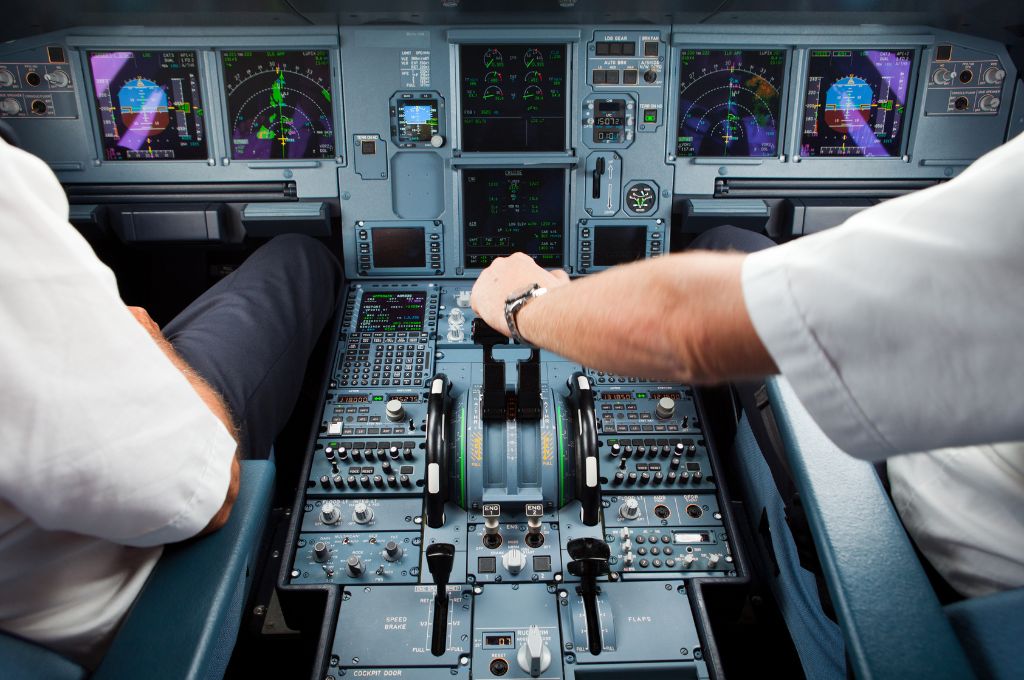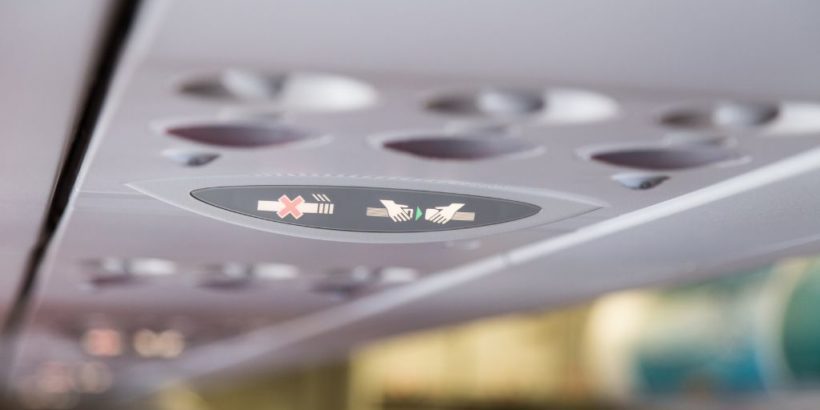I love almost everything about flying except for a few things.
One of these is dealing with stressful bathroom situations that arise when you need to go but the fasten seatbelt sign is on.
Sometimes you can get out of your seat without a problem but other times you might receive the scolding of a lifetime.
So what exactly does the fasten seatbelt light mean and when is it okay for you to head to the bathroom when that light is on?
Let’s take a deep dive into the issue and see what the law states as well as how things have played out in the past.
Note: nothing in this article constitutes legal advice.
Table of Contents
Can you go to the lavatory when the fasten seatbelt sign is on?
During taxi, takeoff, landing, and strong turbulence you should avoid going to the lavatory as much as you can if the fasten seatbelt sign is on. Otherwise, you could run into trouble.
If there is little to no turbulence while at cruising altitude you can often head to the lavatory without any issues.
However, you should always comply with a flight attendant’s request for you to head back to your seat unless you can explain to them why that’s not a viable option.

The law
Federal law says you “shall” fasten your safety belt and keep it fastened while the “Fasten Seat Belt” sign is lighted.
And 14 CFR § 91.11 says no person can “interfere” with a crew member in the performance of their duties.
Interfering could come in many different forms but it could include disobeying “repeated requests to sit down or return to your seat.”
That’s a situation that could definitely arise when heading to the lavatory.
If you are found to have interfered you could end up with a fine of up to $25,000, which could’ve probably gotten you a much more comfortable seat in first class (with a much better bathroom).

Why is there a fasten seatbelt light?
One of the main reasons for the seatbelt light is to protect both you and the airlines.
Events like 9/11 obviously affected the comfort levels with people getting up out of their seats and heading towards the cockpit so there’s definitely a security aspect to this rule.
But it’s also largely about liability.
If the airline does not warn you about keeping your seatbelt on and you get rocked by turbulence while walking down the aisle, not only will you have hospital bills but the airline may have to pay for those.
Different reasons why the fasten seat belt sign comes on
It really helps to understand a few of the different reasons why you might see the “Fasten Seat Belt” light come on.
Operations and the law demand it
You’ll always find the seatbelt light on during taxi, takeoff, and landing. It’s the law.
During these times expect flight attendants to be very strict about you even hinting at getting up out of your seat, as one seatbelt click will trigger the crew’s seemingly ultrasonic hearing.
If you’re just taking off, you may not have to wait very long for the sign to turn off.
There’s no specific cut off such as 10,000 feet where the fasten seatbelt sign will go off because it’s something that the captain will decide based on the current conditions in the sky.
Sometimes that means waiting until you’re stable at cruising altitude which can be hit within 10 minutes.
The most stressful scenario to be stuck in is having to go really bad during the taxi.
That’s because the taxi can be delayed indefinitely and sometimes tragically long.
If you just had absolutely no choice and went to the lavatory during taxi, that’s better than going in your seat but be prepared for some serious issues.
For example, the entire plane may be halted, announcements made, and you will become the star of the show.
In some situations the plane may have to return to the gate and you might even get removed from the plane.
That doesn’t necessarily mean you’ll face legal consequences or get arrested but…
Sometimes the situation can escalate and if you came off as threatening or harassing, you could certainly get in hot water.
If you want to avoid situations like this then be sure to check out our tips below which should reduce the odds of something like this happening.
Light turbulence
A lot of times the seatbelt light will come on whenever the aircraft is experiencing or expecting mild or light turbulence.
In these cases, the law still technically says you should be in your seat but in practice it’s a judgment call and flight attendants will still “allow” you to use the lavatory.
I say “allow” because it’s not so much them giving you permission.
Instead, they might give you a warning or a heads up that the seatbelt light is on as you make your way down the aisle.
A “proceed at your own risk” type of thing.
However, there is a chance that a flight attendant will tell you that you need to be seated during situations like this and so you should be prepared to comply or (calmly) explain why you can’t comply.
Heavy turbulence
Sometimes the fasten seatbelt sign will come on because you are experiencing heavy turbulence or it’s expected to arrive soon.
Obviously, if it feels like you are bumping along the Oregon Trail it’s pretty clear that you need to be strapped in.
But how would you know if heavy turbulence might be on the way?
Often times, the captain will make an announcement that turbulence is expected for a certain amount of time.
If they think it’s going to be particularly bad sometimes they mention that as well.
But you can also look around and see what the flight attendants are doing.
If they are sitting in their jump seats then that’s a good sign that you should also remain in your seat with your seatbelt on.

The pilots just forget
Pilots are human just like the rest of us and just like we forget things like putting on deodorant, pilots can — *sniffs self* — forget to turn the seatbelt light off.
I’ve definitely been on a smooth flight where the seatbelt sign was basically on the entire time.
Some aircraft may have reminders for the pilot but not all.
Don’t always assume the pilot forgot, though.
Sometimes they are aware of turbulence that could arrive suddenly and they are just being conservative by leaving the light on.

Tips for avoiding bathroom issues
Check the weather
Before your flight, you can check what the weather is going to look like on your route.
You can also use a turbulence map to see what kind of turbulence you could expect.
If you’re going to be flying through storms, jet streams, over mountains, or anywhere else where turbulence could happen then you can mentally prepare yourself for having to deal with the seatbelt sign staying on.
Tell the crew about your worry
If you are truly worried about the bathroom situation and perhaps dealing with something like frequent urination, you can discreetly let the crew know about this whenever you come on board.
That won’t necessarily grant you permission to just get up in the middle of taxi or take off but it could save you from a confrontation in those gray areas.
Set a reminder for 30 minutes to arrival
If it’s possible, try to set a reminder for 30 minutes prior to your scheduled arrival.
Or if you have access to an interactive flight map on a seatback monitor or in the app of the airline you’re flying on, track your estimated arrival time so that you can head to the bathroom about 30 minutes prior to the scheduled arrival.
Descent usually starts 20 to 30 minutes prior to landing but it depends on the length of the route and other factors.
The seatbelt light may come on before the descent begins but you should still be able to head to the lavatory during that time without much fuss.
Just be aware that sometimes the estimated time for arrival is not accurate on the flight maps provided by the airlines!

Ditch the beverages
Drinking alcohol and caffeine before your flight is a known recipe for increasing those bathroom visits.
But also just drinking a lot of water or other beverages could force you to have to go.
Fill up your water bottle but just hold off on drinking until takeoff if you can.
Go during boarding
It’s not always practical but going to the lavatory during boarding (while on the plane) can be the best time to go to the bathroom.
The bathrooms should be the cleanest they will be and this timing allows you to take advantage of the latest time you can possibly relieve yourself before taxi/takeoff.
Sit near a lavatory in an aisle seat
On a typical narrowbody aircraft, there is a lavatory in first class and then one or two in the back of the plane.
It could be a good idea for you to choose an aisle seat located very close to the lavatory so that whenever you get the urge to go you don’t even have to hesitate.
Within a couple of seconds you can be right there without having to keep track of who is in line.
There is debate about whether or not economy passengers can use the first class lavatory. (Generally, you should use the lavatory in your cabin but if you have an emergency you should be able to use any one available.)
Fly first class
Flight attendants in first class may be less likely to push back when you’re heading to the restroom.
So sometimes paying extra for first class can be worth it for people that worry about going to the bathroom.
They still won’t let you get up and go during taxi, takeoff, or landing but up in the sky you may have more leeway.

Have distractions ready to go
When you really have to go to the bathroom one of the best things you can do is to distract yourself.
Have a go to playlist, TV show, or some type of puzzles or games that can take your mind off the fact that you have to go. You might even forget that you need to go by the time the seatbelt light goes off.
Another good distraction could be deep breathing or meditating. You can do that anywhere.
Bring something to help you out
Diapers are something that some people wear to deal with uncontrollable bowel and bladder movements.
If that’s what you have to do then hey, that’s what you have to do. No shame in taking care of your issues.
If you don’t want to deal with the diaper then consider something like a Travel John.
It might present some difficulties using when flying economy but it’s probably doable for some.
What to do if you are in the lavatory when the fasten seatbelt sign comes on
One situation that many passengers dread is the seatbelt light going on when they are already inside the lavatory.
If you are already inside the lavatory when the seatbelt sign goes on then you just need to be prepared for potential turbulence and try to get back to your seat as quickly as you can.
If turbulence is already hitting then you could just remain inside until it feels safe to head down the aisle.
There should be some type of bar for you to grab in the bathroom so that could help you brace for impact. Some airplane lavatories may even have a seatbelt.
Make sure you come out before descent though because planes will not land with someone in the lavatory!
International policies
This article focuses on how things work in the US. Each country may have its own regulations and policies. Be sure to look those up.
Final word
My recommendation is to do everything in your power to avoid heading to the lavatory during taxi, takeoff, and landing.
You will probably not have an issue heading to the lavatory when the fasten seatbelt sign is on during times of little to no turbulence but you should be prepared to comply with the flight attendant if that’s humanly possible.
And if you ever get confronted by a flight attendant do everything you can to avoid coming off as threatening or harassing because that’s an entirely different legal mess you could find yourself in.
Daniel Gillaspia is the Founder of UponArriving.com and the credit card app, WalletFlo. He is a former attorney turned travel expert covering destinations along with TSA, airline, and hotel policies. Since 2014, his content has been featured in publications such as National Geographic, Smithsonian Magazine, and CNBC. Read my bio.

